Peggy Whitson
| Peggy Annette Whitson | |
|---|---|
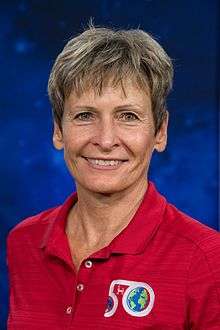 | |
| NASA Astronaut | |
| Nationality | American |
| Status | Retired |
| Born |
February 9, 1960 Mount Ayr, Iowa, U.S. |
Other occupation | Biochemist |
|
Iowa Wesleyan University Rice University | |
Time in space | 665 days 22 hours 22 minutes[1] |
| Selection | 1996 NASA Group |
Total EVAs | 10 |
Total EVA time | 60 hours, 21 minutes[2] |
| Missions | STS-111/STS-113 (Expedition 5), Soyuz TMA-11 (Expedition 16), Soyuz MS-03/MS-04 (Expedition 50/51/52) |
Mission insignia |
|
Peggy Annette Whitson (born February 9, 1960) is an American biochemistry researcher, retired NASA astronaut,[3] and former NASA Chief Astronaut. Her first space mission was in 2002, with an extended stay aboard the International Space Station as a member of Expedition 5. Her second mission launched October 10, 2007, as the first female commander of the ISS with Expedition 16.[4][5] She was on her third long-duration space flight and was the commander of the International Space Station for Expedition 51, before handing over command to Fyodor Yurchikhin on June 1, 2017.
The flight of Space Shuttle mission STS-120, commanded by astronaut Pam Melroy, was the first time that two female mission commanders have been in orbit at the same time.[6][7][8] After completion of her eighth EVA in March 2017, Whitson now holds the records for the oldest woman spacewalker, and the record for total spacewalks by a woman, which was broken by herself again after a ninth and tenth EVA in May 2017,[9] surpassing Sunita Williams, who has completed 7.[10] Whitson's cumulative EVA time is 60 hours, 21 minutes, which places her in 4th place for total EVA time.[2] She is also the oldest female astronaut ever in space, at age 57.[11]
In 2017, Whitson became the first female astronaut to command the International Space Station twice. On April 24, 2017, Whitson broke the record for most total days spent in space by any NASA astronaut, at more than 534 days.[12]
In June 2017, Whitson broke the record for the longest single space flight by a woman which had previously been held by Samantha Cristoforetti at 199 days, 16 hours. Whitson spend 289 days on orbit before returning aboard Soyuz MS-04.[13]
Whitson returned to earth on September 3, 2017 having accrued a total of 665 days in space over the course of her career; the equivalent of a hypothetical round trip to Mars, making her NASA's most experienced astronaut to date. This total was more time in space than any other woman worldwide and any other American.[14] Her Soyuz capsule landed in Kazakhstan shortly after sunrise Sunday—Saturday night back in the U.S.[15]
On June 15 2018, Whitson announced her retirement from the agency, effective on the same day.[16]
Background
Whitson grew up on a farm outside the town of Beaconsfield, Iowa.[3][17] Whitson graduated from Mount Ayr Community High School in 1978 and received a bachelor of science degree in biology and chemistry from Iowa Wesleyan College in 1981. She then went on to earn her doctorate degree in biochemistry from Rice University in 1985, and following completion of her graduate work, continued at Rice as a Robert A Welch Post-doctoral Fellow until October 1986. She is married to Clarence F. Sams[3]
Research career
Following her fellowship at Rice, she began working at Johnson Space Center in Houston, Texas, as a National Research Council Resident Research Associate. From April 1988 until September 1989, Whitson served as the Supervisor for the Biochemistry Research Group at KRUG International, a medical sciences contractor at NASA-JSC.[3]
From 1991 through 1997, Whitson was invited to be an adjunct assistant professor in the Department of Internal Medicine and the Department of Human Biological Chemistry and Genetics at the University of Texas Medical Branch in Galveston, Texas. In 1997, Whitson began a position as adjunct assistant professor at Rice University in the Maybee Laboratory for Biochemical and Genetic Engineering.[3]
From 1992 to 1995, she served as project scientist for the Shuttle-Mir Program and, until her selection as an astronaut candidate in 1996, as deputy division chief for the Medical Sciences division at the Johnson Space Center.[3]
NASA career
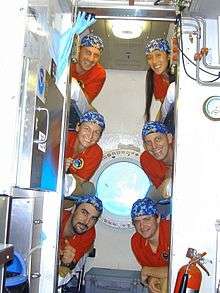
From 1989 to 1993, Whitson worked as a research biochemist in the Biomedical Operations and Research Branch at NASA-JSC. From 1991 to 1993, she served as technical monitor of the Biochemistry Research Laboratories in the Biomedical Operations and Research Branch. From 1991 through 1992, she was the payload element developer for Bone Cell Research Experiment (E10) aboard SL-J (STS-47), and was a member of the US-USSR Joint Working Group in Space Medicine and Biology. In 1992, she was named the project scientist of the Shuttle-Mir Program (STS-60, STS-63, STS-71, Mir 18, Mir 19), and served in this capacity until the conclusion of the Phase 1A Program in 1995. From 1993 through 1996, Whitson held the additional responsibilities of the deputy division chief of the Medical Sciences Division at NASA-JSC. From 1995–1996, she served as co-chair of the U.S.-Russian Mission Science Working Group.
In April 1996, Whitson was selected as an astronaut candidate and started training in August 1996. Upon completing the two years of training and evaluation, she was assigned technical duties in the Astronaut Office Operations Planning Branch, and served as the lead for the Crew Test Support Team in Russia from 1998 to 1999. In June 2003, Whitson served as the commander of the NEEMO 5 mission aboard the Aquarius underwater laboratory, living and working underwater for fourteen days.[18] From November 2003 to March 2005, she served as deputy chief of the Astronaut Office. From March 2005 to November 2005, she served as chief of the Station Operations Branch, Astronaut Office. Whitson trained as the backup ISS commander for Expedition 14 from November 2005 through September 2006, and as the ISS commander for Expedition 16, launched October 2007, on the Soyuz TMA-11. During Expedition 16 she surpassed Sunita Williams for woman with the most spacewalks.[3]
Chief of the Astronaut Office
Whitson was appointed NASA Chief of the Astronaut Office in October 2009, replacing Steven W. Lindsey. Whitson was the first female, and first non-pilot to serve as Chief Astronaut. She resigned when she went back on active flight status in July 2012, replaced by Robert Behnken.
Spaceflight experience
Expedition 5
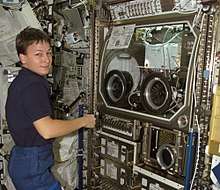
The Expedition 5 crew launched on June 5, 2002, aboard STS-111 and docked with the International Space Station on June 7, 2002. During her six-month stay aboard the Space Station, Whitson installed the Mobile Base System, the S1 truss segment, and the P1 truss segment using the space station remote manipulator system; performed a 4-hour and 25 minute spacewalk in a Russian Orlan space suit to install micrometeoroid shielding on the Zvezda Service Module; and activated and checked out the Microgravity Sciences Glovebox, a facility class payload rack.
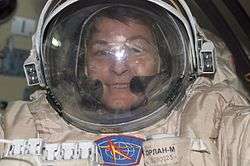
Whitson was named the first NASA science officer during her stay, and she conducted 21 investigations in human life sciences and microgravity sciences, as well as commercial payloads.[19] The Expedition 5 crew returned to Earth aboard STS-113 on December 7, 2002. Completing her first flight, Whitson logged 184 days, 22 hours and 14 minutes in space.
Expedition 16
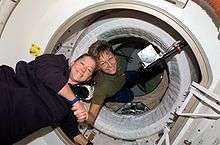
Her second mission, Expedition 16, launched October 10, 2007, on Soyuz TMA-11.[20][21][22] Along with her Expedition 16 crew member Yuri Malenchenko and spaceflight participant Yi So-yeon, she returned to Earth in Soyuz TMA-11 on April 19, 2008. The re-entry was remarkable for the failure of the Soyuz propulsion module to separate properly, and the subsequent "ballistic reentry" which subjected the crew to forces about eight times that of Earth surface gravity.[23] She spent 191 days, 19 hrs and 8 mins in space on this mission.[24]
On December 18, 2007, during the fourth spacewalk of Expedition 16 to inspect the S4 starboard Solar Alpha Rotary Joint (SARJ), the ground team in Mission Control informed Whitson that she had become the female astronaut with the most cumulative EVA time in NASA history, as well as the most EVAs, with her fifth EVA. Three hours and 37 minutes into the spacewalk, Whitson surpassed NASA astronaut Sunita Williams with a total time at that point of 29 hours and 18 minutes.[25][26] At the completion of Whitson's fifth EVA, the 100th in support of ISS assembly and maintenance, Whitson's cumulative EVA time became 32 hours, and 36 minutes, which placed her in 20th place for total EVA time.[26] Her sixth spacewalk, also during Expedition 16, brought her cumulative EVA time to 39 hours, 46 minutes, which ranked her 23rd for total EVA time as of November 2009.
Expedition 50/51/52
_Peggy_Whitson.jpg)
Peggy Whitson arrived at the International Space Station on November 19, 2016,[27] on Expedition 50/51, which was launched on November 17, 2016, from the Baikonur cosmodrome in Kazakhstan.[28] She became the commander of Expedition 51.[29][30] With the launch of Expedition 50/51 with her on it, Whitson, at age 56, became the oldest woman to fly into space.[31][32] During the mission, she broke the record for cumulative time spent in space by a U.S. astronaut, surpassing the previous record of 534 days set by Jeff Williams.[33] In early April 2017, her mission was extended by an additional 3 months at the International Space Station. On September 3, she returned in a previously vacant seat on the Soyuz capsule accompanied by NASA’s Jack Fischer and Fyodor Yurchikhin of Roscosmos.[34]

In January 2017, Whitson performed her seventh EVA. along with Expedition 50 commander Shane Kimbrough. During the EVA, they installed three new adapter plates and hooked up electrical connectors preparing the way to replace the ISS batteries. The EVA lasted 6 hours and 32 minutes. Whitson now holds the record for the oldest female spacewalker, and is now tied with the record for total spacewalks by a woman (seven), along with Sunita Williams.[10] After completion of the seventh EVA, Whitson's cumulative EVA time became 46 hours, 18 minutes, which placed her in 13th place for total EVA time.
On April 24, 2017, Whitson officially broke the record for longest amount of time spent in space by any NASA astronaut.[35] As a result, she received a televised phone call from the Oval Office from US President Donald Trump, the President's daughter Ivanka, and fellow astronaut Kathleen Rubins.[35][36] When interviewed on that day she declared 'It is actually a huge honor to break a record like this, but it is an honor for me back to be representing all the folks at NASA'.[37]
On May 12, 2017, Whitson performed her ninth career EVA with Jack Fischer. After a short delay due to leaking equipment, they replaced an avionics box on the starboard truss called an ExPRESS Logistics Carrier (ELC), a storage platform. The duration was 4 hours and 13 minutes, and it was the 200th EVA to be performed on the ISS.[38]
On May 23, 2017, Whitson performed her tenth career EVA with Fischer. They replaced a backup multiplexer-demultiplexer (MDM) unit that had failed on May 20, 2017. The duration was 2 hours and 46 minutes, making Whitson's cumulative EVA time more than 60 hours, placing her third on the list for most EVA time.[39]
On June 1, 2017, Whitson passed over the command of the International Space Station to Fyodor Yurchikhin, who was named commander of Expedition 52 until he, Whitson and Jack Fischer returned to Earth aboard Soyuz MS-04 in September 2017.[40][41]
Whitson returned to earth on September 3, 2017 after she accrued a total of 665 days in space over the course of her career. This total was more time in space than any other woman worldwide and any other American of any gender.[14] She is ranked 8 on the list of total time spent in space.[42] Her Soyuz capsule landed in Kazakhstan shortly after sunrise Sunday—Saturday night back in the U.S.[15] The duration of her stay in space during expeditions 50/51/52 was 289 days, 5 hours and 1 minute.[1]
Awards and honors
- NASA Outstanding Leadership Medal (2006)
- NASA Space Flight Medal (2002)
- Patents awarded (1997, 1998)
- Group Achievement Award for Shuttle-Mir Program (1996)
- American Astronautical Society Randolph Lovelace II Award (1995)
- NASA Tech Brief Award (1995)
- NASA Space Act Board Award (1995, 1998)
- NASA Silver Snoopy Award (1995)
- NASA Exceptional Service Medal (1995, 2003, 2006)
- NASA Space Act Award for Patent Application
- NASA Certificate of Commendation (1994)
- NASA Sustained Superior Performance Award (1990)
- Medal "For Merit in Space Exploration" (Russia, April 12, 2011) – for outstanding contribution to the development of international cooperation in manned space flight
- Krug International Merit Award (1989)
- NASA-JSC National Research Council Resident Research Associate (1986–1988)
- Robert A. Welch Postdoctoral Fellowship (1985–1986)
- Robert A. Welch Predoctoral Fellowship (1982–1985)
- Summa Cum Laude from Iowa Wesleyan College (1981)
- President's Honor Roll (1978–81)
- Orange van Calhoun Scholarship (1980)
- State of Iowa Scholar (1979)
- Academic Excellence Award (1978)
- Included in the Time 100 list of influential people for 2018.[43]
References
![]()
- 1 2 "Astronaut biography: Peggy Whitson". spacefacts.com. Retrieved September 5, 2017.
- 1 2 Spacefacts (2017). "stronauts and Cosmonauts with EVA Experience (sorted by "EVA Time")". Spacefacts. Retrieved May 13, 2017.
- 1 2 3 4 5 6 7 NASA. "Peggy A. Whitson (Ph.D.)". Biographical Data. National Aeronautics and Space Administration. Retrieved 2007-09-17.
- ↑ Tariq Malik (2007). "Space Station Astronauts Prepare for Crew Swap". Space.com. Retrieved October 9, 2007.
- ↑ Tariq Malik (October 4, 2007). "Astronauts Ponder State of Space Exploration". Fox News. Retrieved October 9, 2007.
- ↑ NASA (2007). "Female Space Commanders Available for Interviews". NASA. Retrieved October 9, 2007.
- ↑ Tariq Malik (2007). "Female commanders set for landmark mission". MSNBC. Retrieved October 9, 2007.
- ↑ Internet Broadcasting Systems, Inc. (2007). "History In Space: 2 Women Commanders". Local6.com Internet Broadcasting Systems, Inc. Archived from the original on June 2, 2008. Retrieved October 9, 2007.
- ↑ Garcia, Mark (March 30, 2017). "Peggy Whitson Breaks Spacewalking Record". NASA.
- 1 2 "Whitson Becomes World's Oldest Female Spacewalker, as EVA-38 Replaces Aging Space Station Batteries". January 6, 2017. Retrieved January 10, 2017.
- ↑ https://plus.google.com/+travelandleisure/posts (2017-03-30). "Peggy Whitson, Oldest Woman Astronaut, Sets New Spacewalk Record | Travel + Leisure". Travelandleisure.com. Retrieved 2017-09-03.
- ↑ "Astronaut Peggy Whitson Sets NASA Record For Most Days In Space". Retrieved April 25, 2017.
- ↑ "Peggy Whitson Space time". Retrieved June 5, 2017.
- 1 2 1:13 PM ET (2017-08-06). "'American Space Ninja' Back On Earth After Record-Breaking Flight". NPR. Retrieved 2017-09-03.
- 1 2 "Astronaut Peggy Whitson returns to Earth after record-breaking spaceflight". Fox News Channel. Retrieved 2017-09-02.
- ↑ https://www.nasa.gov/press-release/record-setting-nasa-astronaut-peggy-whitson-retires
- ↑ Mansur Mirovalev (2007). "Russian Rocket Heads to Space Station". Associated Press / MSNBC. Retrieved October 10, 2007.
- ↑ NASA (March 21, 2006). "NEEMO History". NASA. Retrieved September 23, 2011.
- ↑ Banke, Jim (September 16, 2002). "NASA Boss Names Whitson ISS 'Science Officer'". Space.com. Archived from the original on June 2, 2008. Retrieved September 17, 2007.
- ↑ Sergi Manstov (2007). "Soyuz TMA-11 launches carrying Expedition 16". NASA Spaceflight.com. Retrieved October 10, 2007.
- ↑ Jane Ritikos (2007). "First Malaysian in space". Star Publications (Malaysia). Archived from the original on October 11, 2007. Retrieved October 10, 2007.
- ↑ Shavkat Rakhmatullayev (October 10, 2007). "Russian rocket launches first Malaysian into space". Reuters. Retrieved October 10, 2007.
- ↑ William Harwood (2008). "Whitson describes rough Soyuz entry and landing". Spaceflight Now. Retrieved July 12, 2008.
- ↑ "Soyuz crew endures severe G-forces on re-entry - CNN.com". Retrieved April 25, 2017.
- ↑ CollectSpace (2007). "Astronauts make 100th station spacewalk". CollectSpace. Retrieved December 18, 2007.
- 1 2 NASA (2007). "Spacewalkers Find No Solar Wing Smoking Gun". NASA. Retrieved December 18, 2007.
- ↑ "Welcome Aboard! New Arrivals Make Six Expedition 50 Crew Members | Space Station". blogs.nasa.gov. Retrieved 2016-11-24.
- ↑ "Biography of PEGGY A. WHITSON" (PDF). NASA. 2016. Retrieved 16 February 2016.
- ↑ "NASA, Space Station Partners Announce Crew Members for Missions in 2017". NASA. 6 August 2015. Retrieved 16 February 2016.
- ↑ "ISS Expedition 51 mission patch". collectspace.com. 5 December 2015. Retrieved 16 February 2016.
- ↑ "NASA's Peggy Whitson Becomes Oldest Woman in Space - ABC News". Abcnews.go.com. Retrieved 2016-11-19.
- ↑ Chiara Palazzo Associated Press. "Nasa veteran Peggy Whitson becomes the oldest woman in space as she blasts off for ISS". Telegraph.co.uk. Retrieved 2016-11-19.
- ↑ "Peggy Whitson: Oldest woman in space blasts off to ISS". BBC News. 2016-11-17. Retrieved 2016-12-04.
- ↑ Northon, Karen (April 5, 2017). "NASA Astronaut Peggy Whitson Adds Time to Record-Breaking Mission". Retrieved April 25, 2017.
- 1 2 News, A. B. C. (April 24, 2017). "US astronaut Peggy Whitson breaks American spaceflight record". Retrieved April 25, 2017.
- ↑ CNN, Eleanor Mueller. "Trump to astronaut: 'Better you than me' to drink urine". Retrieved April 25, 2017.
- ↑ Upadhye, Neeti (24 April 2017). "Peggy Whitson Breaks Another Record in Space". The New York Times.
- ↑ "ISS astronauts complete 200th station EVA for maintenance tasks". NASASpaceflight.com. 12 May 2017. Retrieved 13 May 2017.
- ↑ "Peggy Whitson EVA experience". spacefacts.de. May 23, 2017. Retrieved May 23, 2017.
- ↑ "Tearful Whitson transfers ISS command in 'bittersweet' handover". Reuters. June 2, 2017.
- ↑ Garcia, Mark (1 June 2017). "Station Changes Command Before Friday Crew Return". NASA. Retrieved 18 June 2017.
- ↑ http://www.spacefacts.de/english/e_tis.htm
- ↑ Thomas Pesquet (April 2018). "Time 100: Peggy Whitson".
External links
| Wikimedia Commons has media related to Peggy Whitson. |
- Peggy Whitson on Twitter

- NASA Biography
- Spacefacts biography of Peggy Whitson
- NASA Expedition 16
- Peggy Whitson Video produced by Makers: Women Who Make America
| Preceded by Fyodor Yurchikhin |
ISS Expedition Commander October 10, 2007 to April 19, 2008 |
Succeeded by Sergey Volkov |
| Preceded by Steven W. Lindsey |
Chief of the Astronaut Office 2009–2012 |
Succeeded by Robert L. Behnken |
| Preceded by Robert S. Kimbrough |
ISS Expedition Commander April 10 to June 2, 2017 |
Succeeded by Fyodor Yurchikhin |